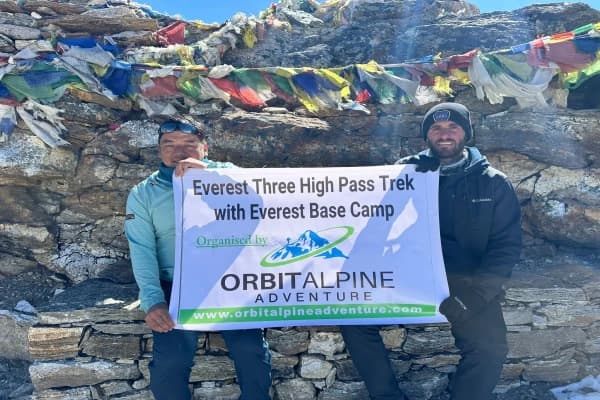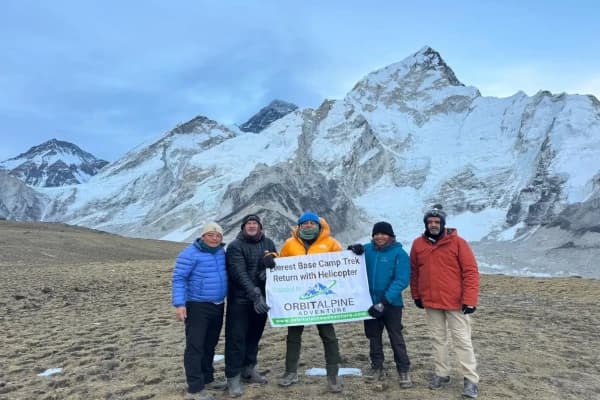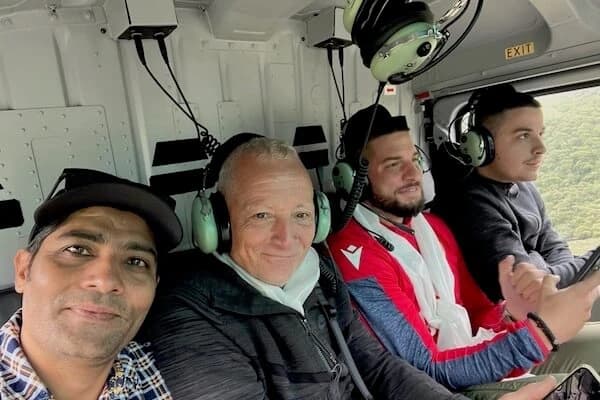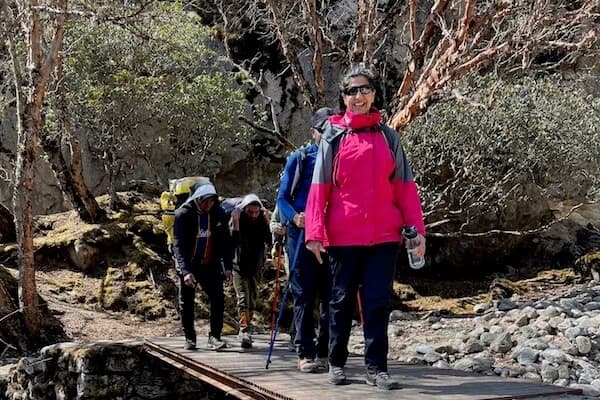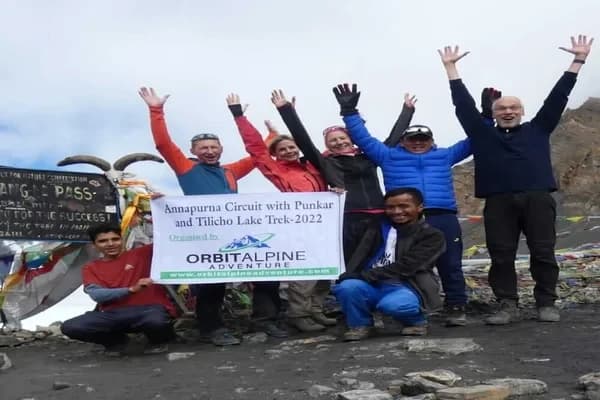The Everest Base Camp Trek is a once in a lifetime adventure offering stunning views of Mount Everest, rich Sherpa culture, and high Himalayan landscapes. This comprehensive guide covers everything you need i.e. from the popular Lukla route and required permits to packing tips, costs, and a day-by-day itinerary. Learn the best seasons to go, how to prevent altitude sickness, and what to expect in terms of food, lodging, and safety. Whether trekking solo or with a guide, this guide helps you plan the perfect trip.
Everest Base Camp Trek Guide
Have you ever dreamt of standing close to the tallest mountain in the world, Mount Everest? Imagine walking on old mountain trails, crossing long hanging bridges, and seeing snowy peaks all around you. Every year, many people visit Everest Base Camp to enjoy beautiful views, learn about Sherpa culture, and feel proud reaching 5,364 meters.
This easy guide will help you with everything you need:
- The popular Lukla route
- What trekking permits are required
- What to pack for the journey
- Best time of year to go
- A clear day-by-day trekking plan
You will also learn about watching sunrise from Kala Patthar, visiting the quiet Gokyo Lakes, and enjoying warm dal bhat in local teahouses. It also explains the costs, how to stay safe from altitude sickness, flights to Lukla, where to stay, and what to eat.
Start planning your Everest Base Camp trek today using this helpful guide. It will make it easier to choose the best season, route, and gear so your dream adventure can come true.
Why Trek to Everest Base Camp?
The Everest Base Camp trek is not just about reaching the base. It’s about the whole adventure from start to finish.
Along the way, you will:
- Walk through peaceful Himalayan villages
- Cross rivers and high suspension bridges
- See huge glaciers and snow-covered peaks
- Visit ancient Buddhist monasteries where monks live and pray
People from all over the world love this famous trek because:
- The mountain views are some of the best on Earth
- You get to meet the friendly Sherpa people and learn about their life and culture
- Reaching Everest Base Camp feels like completing a big life goal or a “bucket list” dream
You’ll also see other amazing mountains such as:
- Ama Dablam
- Lhotse
- Nuptse
And you’ll spend time in popular mountain towns like Namche Bazaar, where trekkers rest and explore.
This Everest Base Camp trek guide helps you understand why each step on this trail is special and why the journey is just as exciting as the destination.
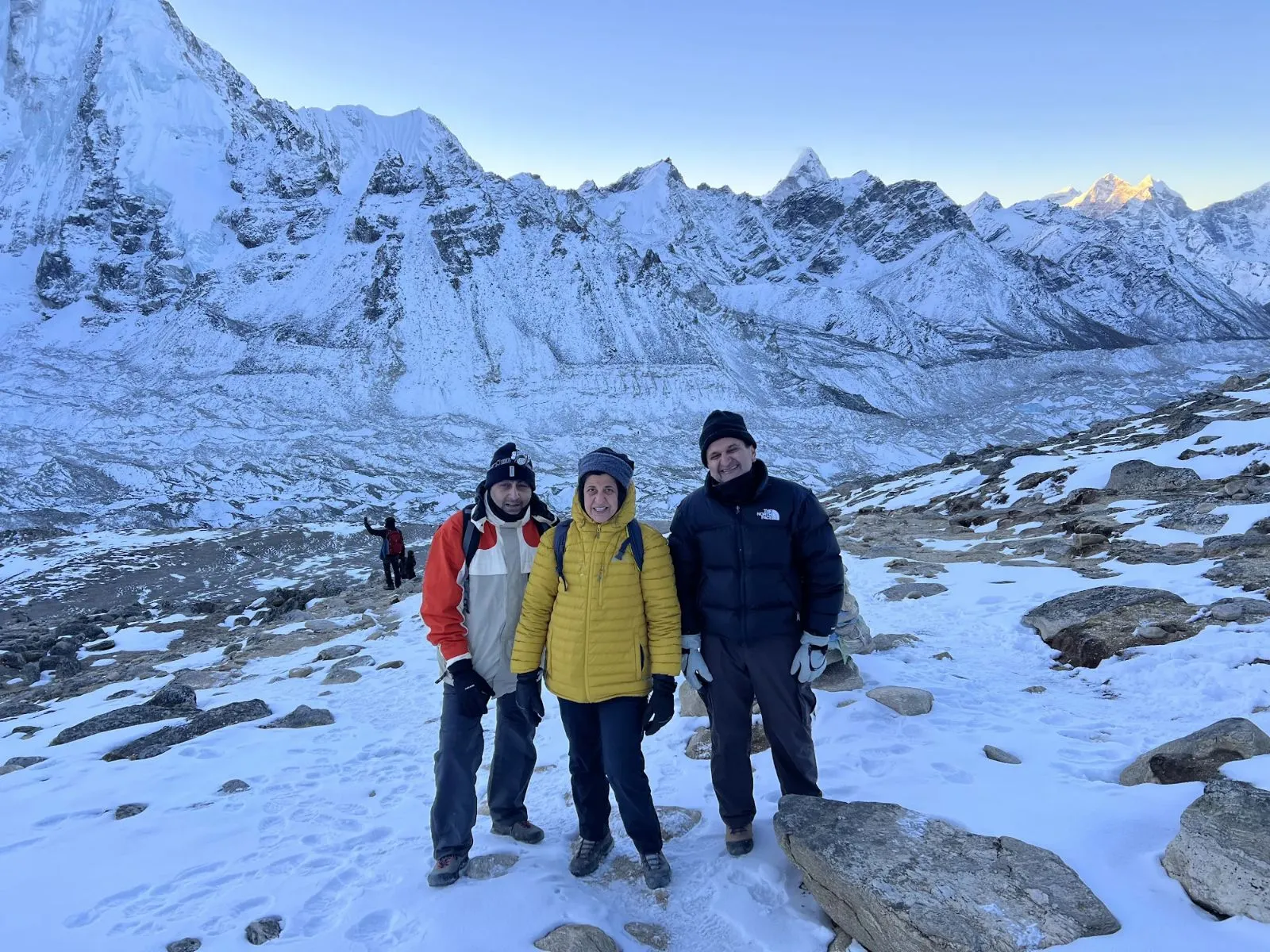
Main Routes to Everest Base Camp
There are different ways to hike to Everest Base Camp. Each path is unique and has its own difficulties. Most people use the popular Lukla route, but other options like the Gokyo trek or the longer Jiri route are also available. The best path for you depends on how fit you are, how much time you have, and what kind of views or experience you want.
Classic Route via Lukla
- Start with a short flight to Lukla
- Walk through villages like Phakding, Namche Bazaar, Tengboche, Dingboche, and Gorak Shep
- Good choice for people trekking for the first time
- Takes around 12 to 14 days to complete
- Many teahouses and food places along the way
- Best for people who are fit and walk slowly to adjust to the high altitude
EBC via Gokyo Lakes
- For trekkers who want fewer people on the trail
- You’ll cross the Cho La Pass and see beautiful blue lakes
- Needs more fitness and some trekking experience
- Amazing mountain views and special places
Jiri to Everest Base Camp
- This was the main route before flights to Lukla started
- It takes more time, but helps your body adjust to the height slowly
- You walk through old, traditional villages and see local village life
- Great for people who have more time and want to explore rural Nepal
Each route offers a unique way to see the Himalayas. Choose the one that best fits your time, fitness level, and the kind of experience you're looking for.
Required Permits and Regulations
To trek in the Everest region, you need two main permits:
- Sagarmatha National Park Permit
- Khumbu Pasang Lhamu Rural Municipality Permit
You don’t need a TIMS card anymore if you’re trekking to Everest Base Camp on your own.
Where to get the permits:
- From the Nepal Tourism Board office in Kathmandu (before your flight to Lukla)
- Or at the Monjo checkpoint on the trail, near Namche Bazaar
Suggestions:
- Always carry your permits with you, as they will be checked at different spots along the trail. For more essential things to arrange before trekking, here’s a list of preparations for Everest Base Camp.
- Bring your passport and enough Nepali rupees in cash, credit cards are not accepted
Best Time to Trek to Everest Base Camp
The best seasons for the Everest Base Camp trek:
Autumn (October–November):
- Clear skies, stable weather
- Crisp air and breathtaking mountain views
- Most popular and busiest season
Spring (March–May):
- Warmer days and milder weather
- Blooming rhododendrons add color to the trail
- Slightly fewer trekkers compared to autumn
Avoiding the Crowds
- For a quieter trek, choose early September or late May
- Expect occasional rain or snow, but enjoy more teahouse availability and peaceful trails
Seasons to Avoid
- Monsoon (June–August): Heavy rains, slippery trails, leeches, and cloud-covered mountains
- Winter (December–February): Very cold temperatures, snowbound passes, and some trail closures
Standard Itinerary for EBC Trek
Here's a standard 12-day Everest Base Camp (EBC) Trek itinerary, commonly followed by trekkers and offered by agencies like Orbit Alpine Adventure:
Standard 12-Day EBC Trek Itinerary
Day 1: Arrival in Kathmandu (1,350m / 4,429ft)
Arrive in Kathmandu and transfer to your hotel. Rest and prepare for your trek.
Day 2: Kathmandu Sightseeing & Trek Preparation
Explore UNESCO World Heritage sites such as Swayambhunath (Monkey Temple), Pashupatinath, and Boudhanath. Attend an evening briefing about the trek.
Day 3: Fly to Lukla (2,860m / 9,383ft) & Trek to Phakding (2,610m / 8,563ft)
Fly over stunning mountain landscapes to Lukla. Begin trekking through Sherpa villages and lush forests to Phakding.
Day 4: Trek to Namche Bazaar (3,440m / 11,286ft)
Move up consistently to Namche Bazaar, the Sherpa capital, with stunning views of Everest and Lhotse.
Day 5: Acclimatization Day in Namche Bazaar
You can take extra walks to Everest View Hotel or the Sherpa Museum to help your body get used to the height and learn about local people.
Day 6: Trek to Tengboche (3,860m / 12,664ft)
Walk down a little to the Dudh Koshi River, then climb through trees to reach Tengboche Monastery.
Day 7: Trek to Dingboche (4,410m / 14,469ft)
Keep walking through villages called Pangboche and Shomare, going up slowly to Dingboche.
Day 8: Acclimatization Day in Dingboche
You can take an extra walk to Nagarjun Hill for great views of the mountains Makalu and Lhotse, which helps your body adjust to the altitude.
Day 9: Trek to Lobuche (4,940m / 16,207ft)
Walk along the Khumbu Glacier to reach Lobuche, surrounded by beautiful mountains.
Day 10: Trek to Gorak Shep (5,160m / 16,929ft) & Everest Base Camp (5,364m / 17,598ft)
Climb to Gorak Shep, then keep going to Everest Base Camp to see amazing views.
Day 11: Early Morning Hike to Kala Patthar (5,545m / 18,192ft) & Trek to Pheriche (4,371m / 14,340ft)
Wake up early to see the sunrise over Everest from Kala Patthar, then walk down to Pheriche to rest.
Day 12: Trek to Namche Bazaar
Start walking back the same way to Namche Bazaar.
Day 13: Trek to Lukla
Keep going down to Lukla, where the trek ends.
Day 14: Fly Back to Kathmandu
Fly from Lukla back to Kathmandu. You will have the afternoon free to rest or see more places if you want.
This itinerary mixes walking days with rest days to help your body adjust to the high altitude. This way, you stay safe and enjoy your famous Himalayan trek more. For more details or to customize your trek, visit Orbit Alpine Adventure.
Optional Suggestion:
If you are short on time or want to avoid walking back, you can choose the Everest Base Camp Trek Return by Helicopter. It gives you a thrilling bird’s-eye view of the Himalayas and saves energy.
Getting used to the altitude in Namche and Dingboche
Taking rest days in this area helps your body adjust to the high altitude and reduces the risk of altitude sickness. You can also take short walks nearby to help your body get used to the height.
EBC and Kala Patthar
From Gorak Shep, you will hike to Everest Base Camp to take pictures. Then, early in the morning, you climb Kala Patthar to see a beautiful sunrise over Everest.
Flights to Lukla and Transportation Info
- Most trekkers fly from Kathmandu or Ramechhap to Lukla.
- Flights may be delayed due to weather, so it’s a good idea to add extra days to your schedule just in case.
What to Do if Flights Are Cancelled
- Take a jeep to Phaplu or Salleri, then add 2–3 days of trekking to reach the main trail.
- Helicopter rides are an option but are expensive.
Places to Stay and Meals Provided During the Trek
- Places to Stay are mostly in tea houses, simple lodges run by local families.
- Rooms usually have basic beds and blankets with shared bathrooms.
- Hot water and heating can be limited, especially at higher altitudes.
Meals
- Common meals include dal bhat (rice, lentils, vegetables), noodles, and fried rice.
- These meals are hearty and give you energy for trekking.
- Some tea houses also offer snacks, soups, and basic Western food options.
Teahouse Facilities and Wi-Fi
- Most tea houses offer paid Wi-Fi and charging services.
- The Internet is often slow and may cut out, especially higher up the trail.
- Connectivity is better in bigger villages like Namche Bazaar but less reliable as you go higher.
- Plan ahead and don’t depend on always being online.
Packing List for the Everest Trek
To stay warm, dry, and comfortable during your trek, pack these important items:
- Clothing Layers: Wear thermal base layers, a warm fleece, an insulated down jacket, and a waterproof jacket to stay safe from wind and rain.
- Trekking Gear: Bring strong trekking pants, warm gloves, a hat or beanie, and several pairs of trekking socks.
- Sleeping Gear: Use a sleeping bag that works well in cold weather, at least -10°C (14°F), to keep you warm at night.
- Hydration: Carry refillable water bottles and a water filter or purification tablets to make sure your water is safe to drink.
- Accessories: Take a headlamp with extra batteries, sunscreen with high SPF, and sunglasses that protect against strong mountain sunlight.
- Electronics and Power Backup: Bring power banks, extra batteries, and solar chargers to keep your devices charged because electricity on the trail is limited or can cost extra.
Budget and Cost Breakdown
Costs for the Everest Base Camp trek vary based on how you plan your trip:
- Independent Trekkers: Around $800–$1,500, covering permits, food, flights, and basic gear.
- Guided Groups or Private Treks: $1,500–$3,000, which includes professional guides, porters, better accommodation, and extra comforts.
Your budget usually includes permits, local flights (Kathmandu to Lukla), meals, lodging, gear, guide and porter fees, plus optional extras like hot showers, Wi-Fi, and tips.
Trekking Safety, AMS, and Emergency Tips
Acute Mountain Sickness (AMS) can affect trekkers above 3,000 meters (9,840 ft). To reduce the risk:
- Climb slowly and take rest days to help your body get used to the altitude.
- Drink lots of water and eat meals regularly.
- Pay attention to signs like headaches, dizziness, or feeling sick; do not ignore them.
- Have travel insurance that covers emergency rescue if needed.
Hiring a Guide or Porter
- Guide: Offers local knowledge, helps with navigation and language, making your trek safer and culturally richer.
- Porter: Carry your heavy bags so you can walk more comfortably and save energy for the trek.
Environmental Responsibility
When trekking in the Everest region, it is very important to protect the fragile mountain environment. Here are some easy ways to help:
- Minimize Your Impact: Stay on marked trails and avoid stepping on plants or flowers. This helps keep nature safe.
- Waste Disposal: Always throw trash in bins or carry it back with you. Never leave plastic or garbage on the trail.
- Leave No Trace: Follow the “Leave No Trace” rules, which means leaving the area as clean as you found it.
- Support Conservation: Choose local guides and lodges that help protect the environment. You can also support groups working to keep the mountains clean and safe.
By respecting nature, you help keep the Himalayas beautiful for everyone.
Alternative Trekking Routes Near Everest
If you want a different adventure near Everest, try one of these exciting routes:
- Everest Three Passes Trek: This trek crosses three high mountain passes. It offers amazing views of the Himalayas and is perfect for experienced trekkers who want a challenge.
- Renjo La Pass and Gokyo Lakes Circuit: This route takes you to beautiful blue lakes and quieter trails. You’ll see stunning mountain views and peaceful villages.
- Island Peak or Mera Peak Climbing: After trekking, many people climb nearby peaks like Island Peak or Mera Peak. These climbs give you a thrilling mountain experience and amazing views from the top.
These routes let you explore more of the Everest region in different ways.
Post-Trek Recommendations
After finishing your Everest Base Camp trek, it’s important to rest and recover. Here’s how you can enjoy your time after the trek:
- Recover Well: Drink plenty of water, eat healthy food, and get enough sleep. This helps your body heal after the long hike.
- Relax and Explore in Kathmandu: Kathmandu has many nice places to relax like cozy cafes, spas, and hotels. You can also visit famous sites like Durbar Square, Pashupatinath Temple, and Boudhanath Stupa.
- Shopping for Souvenirs: Kathmandu offers lots of shops where you can buy souvenirs such as handmade crafts, warm clothes, jewelry, and traditional art. These make great gifts and memories of your trip.
Taking time to relax and explore makes your Everest adventure even more special.
Frequently Asked Questions
How difficult is the Everest Base Camp trek?
The trek is fairly hard because of the high altitude and many days of walking on rough trails. Being fit, mentally ready, and taking rest days to get used to the height are important to have a safe and fun journey.
Do I need a guide or can I trek solo?
You can hike on your own, but it is highly recommended to hire a guide or porter. Guides help you find your way, share local culture, and assist in emergencies, making your trek safer and more enjoyable.
What is the best season to trek to Everest Base Camp?
The best months to trek are March to May (spring) and October to November (autumn). During these times, the skies are clear, the weather is steady, and the mountain views are amazing.
How cold does it get on the EBC trek?
At higher places, the temperature often falls below freezing, especially at night and early morning. A warm sleeping bag and a thick jacket are very important to stay comfortable.
How many days does the Everest Base Camp trek take?
Most people take about 12 days to finish the trek, including days to get used to the altitude. You can finish faster, but taking time to adjust helps reduce the chance of getting altitude sickness.
What kind of accommodation and food can I expect?
You will stay in simple teahouses with basic rooms and shared bathrooms. Meals usually include dal bhat, noodles, and fried rice. Even though the places are simple, the people are very friendly and welcoming.
What permits do I need for the Everest Base Camp trek?
You need two permits: the Sagarmatha National Park Permit and the Khumbu Pasang Lhamu Rural Municipality Permit. You can get these permits in Kathmandu or at checkpoints along the trail.
Can I charge my electronics and use Wi-Fi on the trek?
Yes, but electricity and Wi-Fi often cost extra and can be slow or not work well at higher places. It’s a good idea to bring a power bank or solar charger to keep your devices charged.
What’s the risk of altitude sickness and how can I prevent it?
Altitude sickness can happen above 3,000 meters. To lower the risk, climb slowly, take rest days, drink plenty of water, and pay attention to how your body feels.
How much does the Everest Base Camp trek cost?
Costs can be different for each person. Budget travelers might spend between $800 and $1,500, while guided treks can cost from $1,500 up to $3,000 or more. The main costs are for flights, permits, food, places to stay, and gear.
.webp&w=3840&q=75&dpl=dpl_ExHC4oeA1wubeeTs65CrRaqt7JCa)

